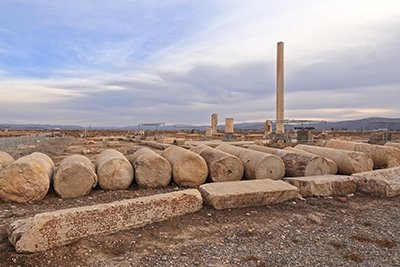
Site visited December 2015. Although this first capital of Achaemenid Empire may feel dull and empty compared to Persepolis, it is still an interesting place to visit.
Getting to Pasargadae by public transport may be tricky. I guess the only way is to take a bus (probably with a bus change in Marvdasht) from Shiraz to Saadat Shahr and try to get a taxi from there. The easiest way is to hire a taxi all the way from Shiraz. It should also be reasonably priced. Fortunately I had arranged a relative of my colleague to be my chauffeur on my day trip to Persepolis and Pasargadae from Shiraz. After visiting Persepolis we stopped by Naqsh-e Rostam and Naqsh-e Rajab TWHS. By the way, I found this site quite impressive and maybe worth of inscription. After that we headed towards Pasargadae which is an hour’s drive from Persepolis. It was already late afternoon when we arrived to the gates of Pasargadae. I spent about an hour and a half at the site and we left at the time of sunset.
Generally speaking there are not that much to see in Pasargadae and the site looks empty. Basically the site consists of seven structures that are scattered around the area of 1,6 hectares. The structures are both modest and low-key, not very well preserved. The distances inside the core zone are so big that it would require a lot of walking if you don't have a car. For that reason many visitors drive from place to place and there is also a shuttle bus option.
Usually a tour in Pasargadae starts from the Mausoleum of Cyrus the Great which is directly after the entrance gate. It is also the most iconic and visited structure of this WHS. There were a lot of local tourists around the mausoleum but not that much on the other places. Apparently for many this WHS is only about the mausoleum. You can notice it also by looking the photos of Pasargadae. Near the mausoleum is the Madrasseh or Mozafari Caravanserai. All what is left of the building is the facade so it is quite a quick visit. The next group of structures is one kilometre away. The remains of two royal palaces, the Palace P or Private Palace of Cyrus the Great and the Palace S or Audience Hall, are next each other and between them is the Royal Garden of Pasargadae World Heritage Site. What is left of the palaces are columns (or stumps of them) that are either standing or lying on the ground. There is not much to see in the earliest known Persian garden either, only some lines and ancient drains can be seen on the dusty ground. On the edge of the palace area is the Gate R building or Gate House which has some interesting carved images. It is the oldest known freestanding propylaeum. Near the palace group is the Zendan (Zendan-e Soleyman/Solomon's Prison) which is a exactly the same kind of building that in Naqsh-e Rostam but only a front facade is left of this building. Usually the tour ends at the citadel of Tall-e Takht (Takht-e Soleyman/Solomon's Throne) which is the furthest structure from the entrance. Basically it is a sturdy wall on top of a hill and a terrace above that. Actually my best memory from my visit is from from Tall-e Takht where I watched a great sunset above Pasargadae.
The destiny of Pasargadae is that it will be always compared to Persepolis because most of the people visit it as a side trip during the same day trip. That said, it is clear that Pasargadae can't win the competition which one is more impressive site. The historical values of Pasargadae are obvious but the experience might be lukewarm. It is worth a detour from Persepolis – if not otherwise at least for two World Heritage Sites.
More on
Comments
No comments yet.
